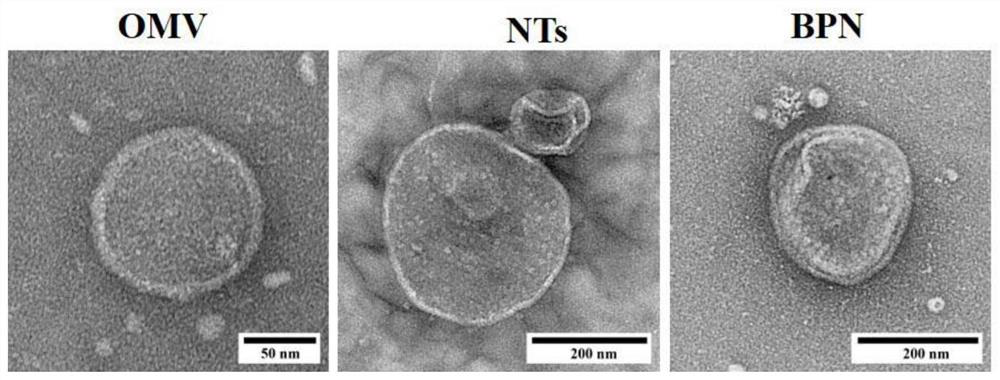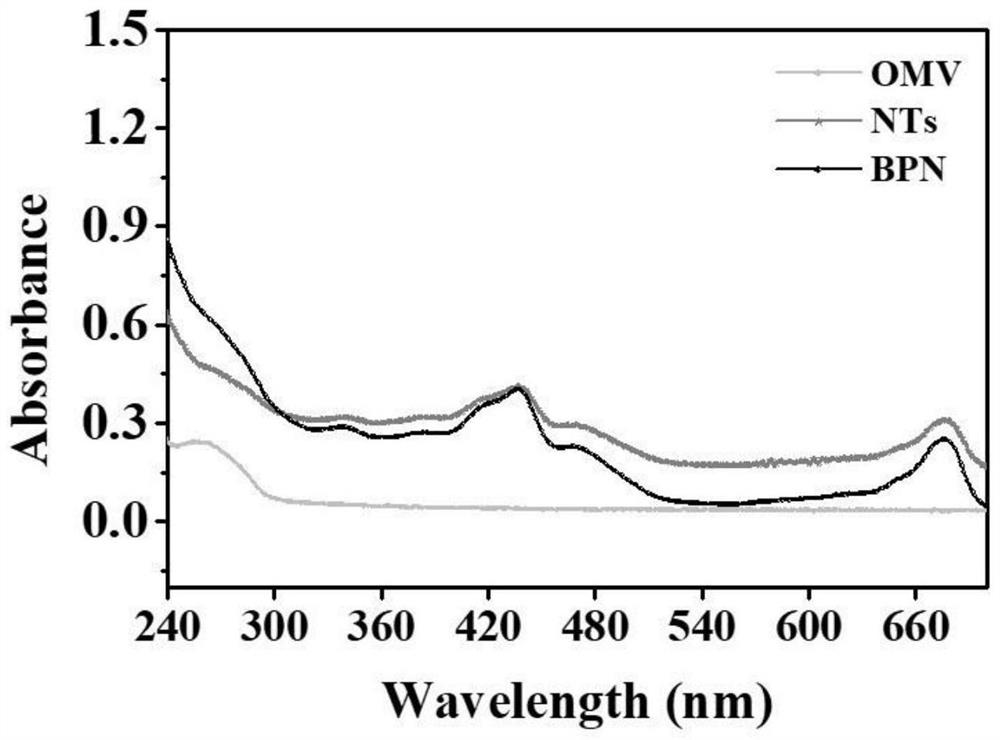Fusion vesicle derived from bacteria and plants as well as preparation method and application of fusion vesicle
A plant-derived, bacterial technology, applied in the field of biomedicine, can solve the problems of unsatisfactory anti-tumor effect, strong toxic and side effects, low blood drug concentration, etc. Effect
- Summary
- Abstract
- Description
- Claims
- Application Information
AI Technical Summary
Problems solved by technology
Method used
Image
Examples
Embodiment 1
[0080] Example 1: Extraction of Bacterial Outer Membrane Vesicles OMVs
[0081] Escherichia coli MG1655 was cultured in 1.5L LB medium at 37°C and 220rpm, when OD 600 When = 1, stop shaking the bacteria, centrifuge the bacterial solution at 10000g, 4°C for 10min, remove the precipitate and get the supernatant; then filter the supernatant with a 0.45μm vacuum filter bottle; use a 100kd ultrafiltration tube to centrifuge at 3000g for 10min to collect the concentrate; The concentrated solution was filtered through a 0.45 μm microporous membrane, and then ultracentrifuged at 4°C and 150,000g for 3 hours; the supernatant was discarded, and the precipitate was resuspended in 400 μL of PBS and stored at -80°C; the concentration of OMV extracted by BCA was 3.48 mg / mL.
Embodiment 2
[0082] Embodiment 2: Extraction of plant thylakoid membrane
[0083] Squeeze and homogenize 300mL BBY-1 and about 100g spinach leaves washed overnight with a juicer, filter the obtained homogenate with 10 layers of cotton gauze to remove residue; centrifuge the filtrate at 10000rpm for 10min, discard the supernatant; suspend the precipitate in In 400mL BBY-2 swelling solution, swell for 2 hours at 4°C in the dark; then centrifuge at 10,000rpm for 10min, discard the supernatant, and wash twice with HEPES (resuspend the pellet in 50mL BBY-2 each time, then centrifuge at 10,000rpm for 10min, discard the supernatant) Thylakoid membrane precipitation was suspended and homogenized in preservation solution BBY-3, and stored at -20°C. According to the above formula, the chlorophyll content measured by ultraviolet spectrophotometry is 0.77mg / ml.
Embodiment 3
[0084] Example 3: Preparation of fusion vesicle BPN
[0085] Take 2 mL of the thylakoid membrane mother solution, wash it with 20 mL of PBS, centrifuge at 10,000 rpm for 10 min, and resuspend the pellet in 5 mL of PBS; ultrasonicate the resuspended thylakoid membrane for 15 min at 4°C and 300 W; Use a manual liposome extruder to extrude through 800nm, 400nm, and 200nm polycarbonate porous membranes in sequence, each membrane corresponds to at least 21 extrusions, and quantify the chlorophyll content in thylakoids with a quartz cuvette The concentration is 102 μg / mL; take 50 μg of bacterial outer membrane vesicle mother solution and 40 μg of thylakoid membrane, dilute to 1 mL with PBS, extrude the mixed solution through a 200 nm polycarbonate porous membrane, and repeatedly extrude at least 21 times; The fusion mother solution was centrifuged at 10,000 rpm and 4°C for 10 min to remove unfused precipitates, and the supernatant was collected; the chlorophyll was quantified again ...
PUM
| Property | Measurement | Unit |
|---|---|---|
| particle diameter | aaaaa | aaaaa |
| particle diameter | aaaaa | aaaaa |
| particle diameter | aaaaa | aaaaa |
Abstract
Description
Claims
Application Information
 Login to View More
Login to View More - R&D
- Intellectual Property
- Life Sciences
- Materials
- Tech Scout
- Unparalleled Data Quality
- Higher Quality Content
- 60% Fewer Hallucinations
Browse by: Latest US Patents, China's latest patents, Technical Efficacy Thesaurus, Application Domain, Technology Topic, Popular Technical Reports.
© 2025 PatSnap. All rights reserved.Legal|Privacy policy|Modern Slavery Act Transparency Statement|Sitemap|About US| Contact US: help@patsnap.com



